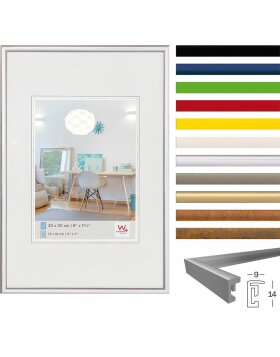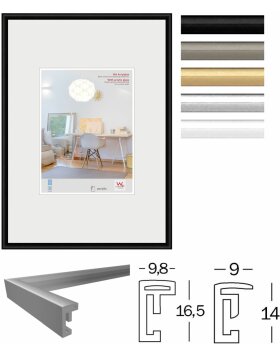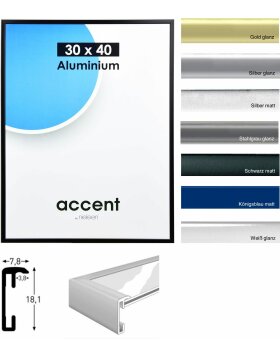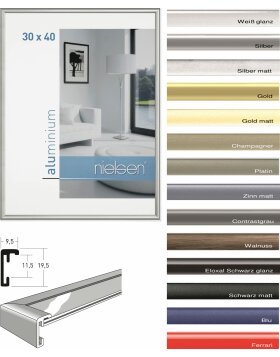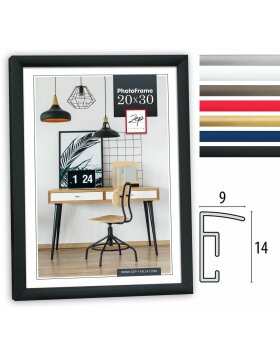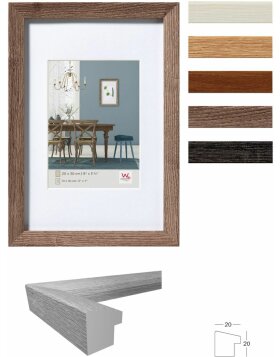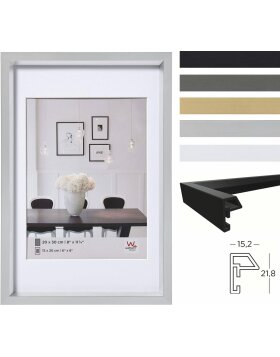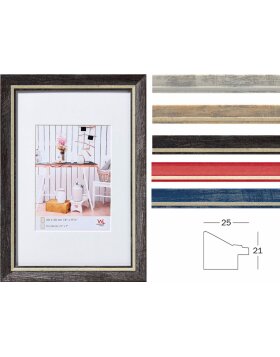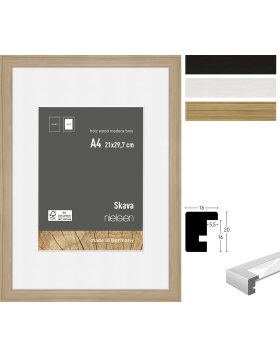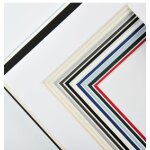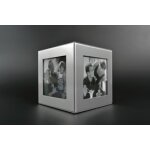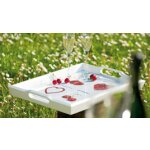Picture frames in our frame shop
BESTSELLER IN THIS CATEGORY
MORE CATEGORIES IN FRAMES
The picture frame: The frame that makes the picture a picture!
A picture frame does not usually play a particularly important role in the ordinary viewing of pictures - for example, pictures in the living room, in the office or in a museum. After all, we are primarily concerned with what is depicted, i.e. with the content of the picture and not with its framing. Picture frames are rather taken for granted. And only when they gleam with gold or other precious metals or are even strikingly decorated with noble ornaments, we can no longer avoid paying attention to them and perhaps even admiring them. And with this matter-of-factness with which we quickly overlook picture frames in everyday life, we also overlook their significance. For it is indeed above all the picture frame that makes a picture objectively a picture. If it is missing, strictly speaking the picture is also missing. No picture without a frame! Nevertheless, there are now countless variations of picture frames - large picture frames and small ones, cheap and expensive picture frames, wooden and plastic frames, analogue and digital picture frames. No matter which picture frame we buy, the objective function always remains the same. So it is time to give the picture frame, its meaning and its history a fitting "frame". An extraordinary look at an ordinary phenomenon!
Buy a picture frame cheap - countless variations to suit individual preferences!
Today, picture frames can be purchased cheaply and are highly customised. Frameless picture holders, wooden frames, picture frames made of aluminium or plastic as well as gallery frames are available in countless variations and shapes. The fact that the picture frame is of such great importance today, namely to support the inner unity and simultaneous delimitation of the picture, hardly seems to be noticed because it is taken for granted. And as is so often the case, we would probably only miss it if it were suddenly no longer there. So every now and then, for example when you buy the next picture frame, it's worth thinking about the small, self-evident things in life. Because often it is precisely them that make the all-important difference.
The big picture frame!
We all have concrete ideas of what a large picture frame/frame is. However, we encounter frames not only in the context of fine art, but also in many other areas of everyday life. We encounter window frames, door frames, gate frames or bicycle frames, for example. We know steel, wooden and plastic frames. We talk about frames and do various things "within the frame" of something. We ask what is going on in the framework programme of a certain event and complain when it turns out afterwards that something has gone beyond the framework. Nobody really needs to explain to us what frames are, and it may seem absurd to attach so much importance to them. However, we will see that dealing with picture frames is by no means uninteresting. All show that a frame is generally something limiting and structuring. It delimits an interior of some kind against an exterior and thus gives the interior a certain independence. But this independence is different from that of a door frame, for example - it is not functional. The door frame, for example, automatically refers to its functional meaning: the framing or anchoring of the door. The picture frame, on the other hand, does give the picture the necessary demarcation from the environment and thus a certain significance. However, this significance - in contrast to the significance of the door frame - is not obvious to everyone and may have to be discovered first. The framed must prove itself in the eye of the beholder, so to speak.
The objective meaning of the picture frame.
Now we can introduce a further distinction: The picture as a picture not only has an external frame - that is, the one that is produced in more or less elaborate manual or industrial work; rather, a frame has always been given to it by nature as well. It is not without reason that the German philosopher and sociologist Georg Simmel wrote the sentence: "In that the work of art is what otherwise only the world as a whole or the soul can be: a unity of particulars - it closes itself off, as a world for itself, from everything external to it." The work of art is a reality in itself, or as Simmel says: a "being-for-itself". The independent meaning of the image, its uniqueness in its difference from the world, always presupposes a limit. An image or a work of art always remains the same as itself, is always indifferent. The consequence of this is that the picture frame, which is, as it were, externally "superimposed" on a picture, in fact enhances the picture, which is already charged with its own meaning and is self-contained. The picture frame appreciates the work of art as a work of art in its uniqueness and wholeness. Against this background, it becomes understandable why, for example, picture frames were integrated into the painting at the beginning of Western panel painting: In this way, the uniqueness of the picture was appreciated and emphasised. According to Simmel, the picture frame reinforces and symbolises the boundary of the work of art in its double function: shielding it from the outside world while simultaneously closing it off from the inside. The viewer is thus also excluded from the work of art or the picture, so that it is precisely through this, from a distance, that he can have an aesthetic experience at all. Or as Simmel puts it: "Antithesis against us and synthesis in itself, are alternating terms; the two first qualities of the work of art." We encounter the work of art or the picture in their own unity, and the function of the picture frame is to emphasise this unity through symbolisation.
This accentuating function of the picture frame, however, can also be seen in its typical building structure. Not only the joints where the sides of the frame meet and which are usually located in the corners of the frame point strictly towards the centre of the picture; the four sides of the frame are also slightly raised on the outside and converge towards the inside, i.e. towards the centre of the picture.
After all that has been said so far, we can now also say why this is so and why it perhaps must be so: Everything points to the inner coherence of the picture; the convergence of the frame sides inwards helps to "complete" the picture. The picture in its uniqueness is emphasised. The picture frame must therefore - metaphorically speaking - do everything in its power to maximise this outwardly and inwardly closed uniqueness of the picture. This also explains why smaller pictures tend to get lush frames, while very large pictures get by with minimal framing or even with a frameless picture frame. Wall paintings, for example, often require only a minimally visible separation between the inside of the picture and its surroundings. The picture frame, it can be summarised in the meantime, should always only be a servant to the picture or the work of art and not vice versa. A picture frame that literally breaks the frame undermines the individuality of a work of art and competes with it. Such a frame misses its point.
But how can we now explain that particularly old picture frames, for example, were very generously and elaborately designed? In some cases, the sides were formed by columns supporting a pediment, and in the Rococo - the late Baroque - there were even frame forms that contained openings and forms of dissolution. Doesn't the latter in particular speak against everything that was said earlier regarding the closure of the picture on the outside and inside by the picture frame? Both examples have in common the structure that the picture frame as a frame moves into the foreground or at least receives a strong enhancement. A powerful, voluminous and meticulously decorated frame is even necessary to a certain extent as long as the picture that is framed has a strong external reference, or its unity is not considered strong enough. How is this to be understood? In order to do so, one must visualise the actual contents of the pictures that were enclosed in those old, architecturally heavy picture frames. These were mostly pictures and paintings with religious references. The pictures thus had God-serving purposes and aimed at a religious experience. In addition, banners and the like were addressed directly to the viewer. In this way, the artistic unity of such pictures and works of art came under threat; their independence as works of art threatened to fall to pieces behind the quasi-divine backdrop, whereupon a thick and heavy frame construction sought to preserve this unity. The picture frame thus signalled absolute impenetrability and thus retained its original function. In this respect, Simmel also draws the following conclusion: "The more the work of art rejects such relations beyond it, the more it can dispense with the framing forces which, through their own organic vitality, nevertheless disavow their serving function. The situation is somewhat different with picture frames that have openings or are exaggeratedly designed. The unity that they are supposed to guarantee is thus partially dissolved. This, too, is not a contradiction to what has been said so far. For here the picture frames made in this way take on an artistic significance of their own. They move completely into the foreground and become works of art in their own right. Strictly speaking, they therefore no longer need any picture content that would merely compete with them. The picture frame as a work of art is thus something categorically different from the picture frame in its picture-serving function.
Now we can observe that in the course of the history of mankind and art, picture frames have always become more functional, more pragmatic, i.e. ultimately more useful for pictures. If we ask ourselves what this means, we can conclude on the basis of what has been formulated so far that this represents a development that has successively granted and given the work of art as a work of art an independence, indeed an individuality, that no longer needed to be protected by over-massive picture frames. If the picture in the religiously influenced and corporately organised medieval or ancient society was still merely - to speak again with Simmel - a part of a superordinate whole, in modernity it became a whole itself. Accordingly, picture frames became smaller and thinner, because from then on it was a matter of individuality, of the uniqueness of the framed work of art itself. It is also astonishing to see that this development ultimately also expresses the change in the relationship between the individual and society. Thus, in the process of civilisation, the individual became increasingly detached from his local milieu of origin, was increasingly able to decide for himself which profession he would take up, which religion he would prefer and which political convictions seemed appropriate to him. In short, the individual - like the work of art - was granted his or her individuality.
The picture frame: A short history!
After this rather sober presentation of the supposedly trivial significance of the picture frame, it is worth taking a brief look at its history. We have already established that the architecture of frames developed analogously to the social development towards modernity. The picture frame was to some extent an expression of the social change that consisted in placing the subject or the individual at the centre and granting him or her more autonomy and self-determination. And so the work of art also became increasingly independent and no longer had to be protected by an oversized picture frame.
Until the 13th century, picture frames were mainly made of stone. Reliefs and church pictures were primarily set into them. Many pictures were painted directly on church walls. The modern picture frame, on the other hand, only became thematic in the Gothic period (12th - approx. 15th century). Especially in Italy, art and painting became increasingly important. People began to paint altars that stood freely. Eventually, the painted altarpieces were framed in wooden frames and the frames in turn were ornately decorated and painted. The Renaissance then brought the picture frame into middle-class households. The aforementioned independence of the work of art increasingly came to the fore; pictures were hung at home for decorative purposes and the art of picture frame making was also increasingly refined. Picture frames became more and more functional, not least because of the spread of mass industrial production. Today, a distinction is made between industrially manufactured mass products and picture frames that are still made by hand. And while industry largely relies on various types of wood, plastics and aluminium as basic materials, handcrafted frames are still made exclusively of wood. But here too, the picture frame has to fulfil a function that always serves the picture.
In this respect, it is also interesting that today there are frames that are called "frameless frames". These are special clip frames that are basically intended to fulfil a purely protective function. However, it must then also be said more precisely that they are not picture frames either, as they do not emphasise the uniqueness of the content, but merely seal it off against direct environmental effects. The content, such as a document or a photograph, does not need to be more strongly demarcated from the outside here, since it obviously does not possess the independence of a work of art - but in the case of the photograph, it can possess it. A work of art, on the other hand, marks its own level of reality.
Buy picture frames with us: Here you will find a huge selection of different frames!
Our range of picture frames is very large and varied. Whether you are looking for a frameless picture holder, a wooden frame, a picture frame made of aluminium or plastic or a gallery frame, in our shop you are guaranteed to find the frame that exactly meets your expectations! A frameless picture holder, also called a clip frame, is a sturdy back panel and a matching glass pane that are connected to each other by a corresponding clip fastener. By dispensing with a frame rail, these picture holders are particularly inexpensive.
The use of wood as a frame material is the well-known classic. Since the wood material can be processed and worked in many different ways, a wealth of moulding shapes and colours are possible. There is a suitable wooden frame for every style.
Aluminium frames captivate with their classic elegance. The matt anodised profile guarantees you colour fastness and stylish simplicity even after years. They convince with impeccable function, stability and durability. And all that with a small weight.
Plastic frames are a perfect combination of modern design and classic elegance. They convince with their simple look and an appealing price. The colour palette is huge and invites you to browse! The plastic frames are available in many different formats, with practical closure systems and robust hangers.
The so-called gallery frames also offer many new design and presentation options for your favourite photos.
The different variants of multiple frames are called gallery frames. Their design is available with many different numbers of pictures. This allows you to include a larger number of pictures in different formats as well as to combine a few photos of the same format. The gallery frame offers space for many pictures, but if you want to create an entire photo album, for example from your last holiday, you will also find a large selection in our shop!
Another distinction in the designation of picture frames is that between portrait frames and table frames. Despite their name, portrait frames are not only to be used for portraits, but also for all other motifs such as landscape photos, wedding photos and family photos.
A table frame is available to match almost any interior design style. Whether you prefer country style, modern or shabby chic, here at fotoalben-discount.de you will find the perfect frame for your table.
With such a wide selection, you can be sure to find the picture frame that meets all your requirements. And to match the picture frame, we naturally also have a passepartout. Whether for standard formats or in special sizes - we will cut your bevelled passepartout for you with computer-aided precision to 0.1 cm. The passe-partout board we use is acid-free and has a white core.







